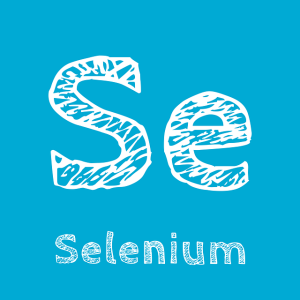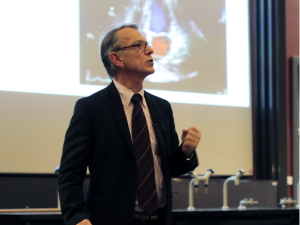In humans, Selenoprotein P is the selenium-dependent compound that serves as the primary selenium transport protein in the blood circulation. Selenoprotein P, abbreviated SELENOP, is synthesized in the liver. From the liver, then, it carries selenium out to the peripheral cells and tissues. In this way, it is responsible for ensuring selenium homeostasis throughout the body [Schomburg 2022].

In addition, SELENOP plays a role in the antioxidant defense of the organism. It acts as a scavenger of harmful free radicals. It also supports the activity of the glutathione peroxidases and the thioredoxin reductases. These selenium-dependent enzymes have a major role in the antioxidant protection of the cells. Given its antioxidant effects, SELENOP helps to modulate immune system responses [Schomburg 2022].
Selenium deficiency is associated with increased risk of neurological disorders. Adequate SELENOP levels are required for proper brain development and health [Rayman 2012].
Serum SELENOP and Serum Selenium Levels
In healthy adults, the serum SELENOP concentration needs to be between 5.0 and 10.0 mg/L. These levels of SELENOP correspond to serum selenium status between 90 mcg/L and 135 mcg/L [Schomburg 2021 Aug, Fig. 4]. The above comparisons between serum SELENOP levels and serum selenium levels are rough equivalencies.
Note: Serum SELENOP is measured in milligrams/L and not in micrograms/L as serum selenium concentrations are. The reason is that SELENOP molecules have much more mass than selenium atoms do.
There is a rough correlation between the serum selenium concentrations and serum SELENOP concentrations. This correlation is more apparent in study participants with lower selenium status. It is not possible to extrapolate serum SELENOP values from the available serum selenium equivalencies. The relationship is not strictly linear. With increasing serum selenium levels, the SELENOP level begins to saturate. Above serum selenium concentrations of approximately 135 mcg/L, the level of circulating SELENOP describes a plateau [K. Demircan, private communication, 11 Nov. 2024].
Selenium Supplementation and Serum SELENOP Saturation
Available research evidence seems to show that SELENOP plateaus at serum selenium concentrations of 120-130 mcg/L [Larsen 2024; Hurst 2010]. How long it takes selenium supplementation to achieve SELENOP saturation depends upon the individual’s baseline selenium status and the selenium species and dose used in the supplementation. Typically, it takes somewhere between four weeks and 30–40 weeks for selenium supplementation to reach the SELENOP saturation level [Alexander & Olsen 2023].
In selenium-replete individuals, supplemental selenium intakes will not result in an increase in SELENOP. In this respect, the United States is different from much of Europe and the Middle East. In the US, adults have a mean unsupplemented plasma selenium concentration of 122 mcg/L. Selenium supplementation will increase these individuals’ serum selenium concentrations but will not appreciably increase serum SELENOP levels [Alexander & Olsen 2023].
By comparison, the mean plasma/serum selenium status of adults in Denmark, Norway, and Sweden are all below the 90 mcg/L mark. Finland, which adds selenium to crop fertilizer, manages a mean plasma selenium concentration of 110 mcg/L [Alexander & Olsen 2023].
Selenium Supplementation and Plasma/Serum Selenium Level
In a study using a selenium-enriched yeast preparation, 10 weeks of daily supplementation of healthy UK adults aged 60-74 years raised the study participants’ plasma selenium concentrations from with a mean baseline level of 95.7 mcg/L as follows [Hurst 2010]:
- 50 mcg/day raised plasma levels to 118.3 mcg/L
- 100 mcg/day raised plasma levels to 152.0 mcg/L
The researchers reported that the study participants received approximately 55 mcg of selenium in their diets. They needed a daily supplement of 50 – 100 mcg to achieve a sufficient selenium status for antioxidant protection [Hurst 2010].
Selenium and Coenzyme Q10 Supplementation in Sweden

In a KiSel-10 sub-study, researchers determined SELENOP levels at the study start and again after four years of supplementation. The study participants were 403 elderly community-living individuals who were low in selenium at baseline. They received selenium from selenium yeast (200 mcg/day) and Coenzyme Q10 (200 mg/day) or matching placebos [Alehagen 2024].
The selenium supplementation induced higher circulating levels of SELENOP. In the supplemented group, SELENOP saturation was achieved at a serum selenium level of 146 mcg/L [Alehagen 2024].
The KiSel-10 researchers observed the following significant associations:
- inverse association between SELENOP level and inflammation
- positive association between SELENOP level and length of telomeres
- positive association between SELENOP level and quality of life
- inverse association between SELENOP level and mortality
The researchers reported that the SELENOP concentration had increased prognostic power compared to selenium concentration and GPx3 concentration. They concluded that selenium supplementation improved SELENOP expression. This, in turn, facilitated systemic selenium bioavailability and resulted in positive health effects [Alehagen 2024].
Conclusion: SELENOP as a Biomarker of Selenium Status
The plasma/serum SELENOP concentration is regarded as the most appropriate biomarker of the selenium status [Schomburg 2022].
The maximal expression of SELENOP occurs at a plasma/serum concentration of selenium of 110 mcg/L or slightly higher. Plasma and serum selenium values are equivalent [Alexander & Olsen 2023].
Dietary intake levels in the Nordic countries except for Finland are too low to achieve optimal levels of SELENOP [Alexander & Olsen 2023].
Sources
Alehagen U, Aaseth J, Schomburg L, Larsson A, Opstad T, Alexander J. Selenoprotein P increases upon selenium and coenzyme Q10 supplementation and is associated with telomere length, quality of life and reduced inflammation and mortality. Free Radic Biol Med. 2024 Sep;222:403-413.
Alexander J, Olsen AK. Selenium – a scoping review for Nordic Nutrition Recommendations 2023. Food Nutr Res. 2023 Dec 28;67.
Hurst R, Armah CN, Dainty JR, Hart DJ, Teucher B, Goldson AJ, Broadley MR, Motley AK, Fairweather-Tait SJ. Establishing optimal selenium status: results of a randomized, double-blind, placebo-controlled trial. Am J Clin Nutr. 2010 Apr;91(4):923-31.
Larsen C, Winther KH, Cramon PK, Rasmussen ÅK, Feldt-Rasmusssen U, Knudsen NJ, Bjorner JB, Schomburg L, Demircan K, Chillon TS, Gram J, Hansen SG, Brandt F, Nygaard B, Watt T, Hegedus L, Bonnema SJ. Selenium supplementation and placebo are equally effective in improving quality of life in patients with hypothyroidism. Eur Thyroid J. 2024 Jan 1;13(1):e230175.
Rayman MP. Selenium and human health. Lancet. 2012 Mar 31;379(9822):1256-68.
Schomburg L. Selenium deficiency due to diet, pregnancy, severe illness, or COVID-19-A preventable trigger for autoimmune disease. Int J Mol Sci. 2021 Aug 8;22(16):8532.
Schomburg L. Selenoprotein P – Selenium transport protein, enzyme and biomarker of selenium status. Free Radic Biol Med. 2022 Oct;191:150-163.
The information presented in this review article is not intended as medical advice. It should not be used as such.
